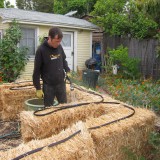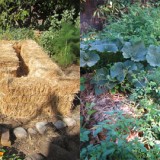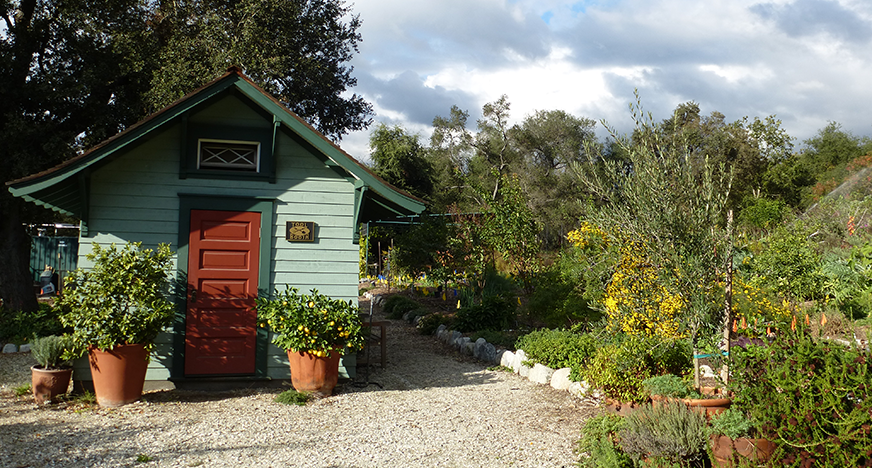
The new hexagonal raised beds. More on the design in another post.
Due to contaminated Los Angeles soil, we’ve got to grow our veggies in raised beds. There’s just too much lead and zinc in the ground, according to our local soil lab. Putting together three new beds recently got me to thinking about the ups and downs of gardening in raised beds. I thought I’d list off the pros and cons:
Pros:
- Keeps roots away from contaminated soil.
- Good for disabled or elderly gardeners.
- Neat.
- If high enough, can keep out some critters–and keep veggies above the dog pee zone.
- Plug and play–no need to build or improve soil.
- Keeps roots from getting waterlogged in a wet climate.
Cons
- Requires materials to construct.
- Might need to buy soil–gardening in the ground is free.
- Roots dry out quicker in a hot climate.
- Lack of mineral content in bagged soils.
- Use of peat moss in bagged products.
- Unable to truly embrace the “no dig” philosophy: despite best efforts to the contrary, it seems the soil needs to be swapped out every few years. It’s container gardening, really.
Going through that list of pros and cons, if it weren’t for our contaminated soil it would be better for us to grow in the ground. From a water use perspective, in Mediterranean climates such as ours, it’s better to garden at ground level. Less evaporation. In dry desert climates such as New Mexico it’s often better to garden slightly below grade to take advantage of summer rains. Conversely, in soggy climates raised beds have some advantages.
Another factor is cost. A bulk soil order doesn’t start to make sense until you’ve got a lot of raised beds to fill or neighbors to split the order with. This leaves me stuck with bagged products. I’m testing out a variation on Mel’s mix: one part coconut coir, one part vermiculite, one part compost. It’s still expensive, but at least I’m weaning myself from peat moss, an unsustainable product. Unfortunately, all those bags have to be hauled up thirty steps.
As a whole, what we’ve done with our garden is a compromise. Most of the yard is permaculturish: lots of small fruit trees, some native plants, ornamental flowering plants for the wildlife and a whole lot of mulch. But I like to have a few Italian veggies so we’ve got five small raised beds.
Did I leave anything off this list of raised bed pros and cons? What are you growing your veggies in? Leave a comment!






This is very interesting to me as I’m heading back to Missouri (family has a century farm there), to do a little bit of farming and was planning on experimenting with both raised bed farming and in-ground farming (small plots on an acre and a half..or so), along with high tunnels, low tunnels, etc. Our moisture levels would be, I suspect, much higher than yours. The soil itself is silty-loam, my mother knows about the soil. Anyway this, to me, is (was) a very interesting post.
For what it’s worth, on the DVDs of a 1995 Permaculture Design Course given by Bill Mollison and Geoff Lawton (available at the Tagari site), it is claimed that the heavy metals in soil are only really problemaric in extremely acidic soils (pH of ~ 3.5 and lower). In pH neutral or alkaline soils, or even mildly acidic soils, there is supposedly no danger from heavy metals binding with elements that could cause them to be assimilated by the body. Also, they point to various methods of soil remediation that over time can reduce or eliminate the problem; eg, thru maintaining pH balance, the use of fungi and plants that accumulate heavy metals, using contaminated soils to grow biofuel crops, etc., as in “the problem is the solution.”
I should have noted that our local lab measures plant-available heavy metals, that is what a hypothetical plant is taking up. This takes into account the alkalinity of our soil. Of course plants vary in how much metal they will take up–fruit and tomatoes are perfectly fine in our soil. Others, such as spinach, take up a lot of metals and would not be ok to eat. I looked into various remediation ideas and came to the conclusion that they weren’t practical on a residential level. But perhaps I should revisit this.
I found one of the big problems with raised bed was the wood rotting and having to be replaced.We didn’t use cedar,which may last longer, we used the treated wood(yea, I know it’s bad and I wouldn’t use it now)After about 10 years all the wood rotted and had to be removed.
The one item on your list was continually having to buy new soil in bags…all that plastic!!!
Our flower and veggie beds are a wee bit higher that the surrounding ground and I have them edged with stone.
In colder climates, the big benefit of raised beds is that they warm up earlier in the spring than the ground does, so you can plant/sow seeds much earlier in the season. But the con here is that if you keep perennials in there, they are more exposed to frost. I get that this is of no concern in Los Angeles, but here in Norway it’s a big point. 😛
I personally love them, and wouldn’t want to garden without them. Great for people with achy backs! 🙂
I find a big benefit to be fewer weeds. The creepers have a harder time establishing and spreading, for me.
We should have mentioned that as a point. Intractable crab grass and other unstoppable weeds can be a real problem for some people, and raised beds really help with that. Along the same lines, you can put wire in the bottom of the beds to keep out gophers–another intractable problem.
I don’t have any scientific studies to back this up, but I think I would add soil food web to the disadvantages. If the level of the soil is changing up and down by 2 feet across the garden, I can’t help but think that the strata of a healthy soil would be at a disadvantage.
Good point.
Before I retired, I operated a 65-member CSA that was on 1-acre of a large dairy farm. The main growing area was 66-hand dug raised beds. Each was 100 ft. sq. It made planning much easier particularly for helpers I had because they were all in a grid system and labeled – everyone knew where to find bed A22 without me showing them. It also made crop rotation simple – everything just shifted down each season. At first they were free standing, as John Jeavons advocates, but over time as the fencing at the dairy started to be replaced I started using the fence boards. In the end I had about 20 of the beds framed with boards. It was fairly easy to keep the beds weed free, but the path ways were another matter. Unfortunately it took the woman that came after I left only one season before the entire area was obliterated with weeds. I learned a lot during the 12 years I was there. One, all pathways take up valuable space. If you are really trying to raise as much food as possible in a small area then pathways present a problem. That said I still have pathways – they’re just a lot narrower now. Second, I never want weed pathways again. So at my current location my beds are 4’ X 12’ and I first laid down heavy duty landscape fabric over the entire area. Then made a 12’ X in the fabric and rolled each landscape timber up. I then graveled everything that wasn’t a bed. In the last four years, I haven’t once had to weed the paths.
We are lucky that we moved just outside the city limits with our tiny house recently, so we get the benefits of a teeny-tiny commute to downtown but we can do lovely things like grow in THE GROUND and have more livestock. 🙂 We have a small permaculture community homestead, so we also have a lot of fruit and nut trees, medicinal herbs, and many hugelkulturs. Hugelkulturs are something I would highly recommend to anyone who struggles with water issues–whether too much drainage (dry soil) or too little drainage (high water table). For those on the dry side, it pulls up the moisture from deep below into the area where the roots of your veggies are, and for those on the wet side it raises the level of your soil over time. A win-win! Alas, it sounds like a hugel is not in the cards for you guys anytime soon, but I highly recommend them for anyone who does not have contaminated soil underneath. In fact we’re building one in the shape of a gorgeous spiral right now to plant herbs into.
There are a few people experimenting with hugelkultur here in Los Angeles. I’ve been curious to see if this strategy is appropriate for our climate.
I would be curious to hear about the folks in your area trying hugels out, as we currently live in the PNW but may be moving to a desert climate in the next year or two and are doing a lot of research about what techniques will and won’t work in those more arid areas. Any links you have would be much appreciated! 🙂
I’m going to put out a call on this blog next week to ask if anyone has done hugelkultur in a dry climate. I’ll also do a literature search and see what turns up.
I’m looking forward to reading more about this. I think I have the raw materials…
Thanks for looking into this! I’m excited to hear what others have done/are doing in dry climates with hugels, as my own research has come up dry (hehe) on this. I haven’t yet found many examples where folks have shared their method and process for their hugels in dry arid climates.
We just had a couple of cedar beds built last year and we’ll be using them for the first time. I’m a little worried about keeping them watered during the intense heat of our southern summers. I’ve thought about using an olla. Has anyone had experience with those?
Funny you should mention this. I have a new olla waiting to go into one of the beds.
I wonder why you add coir to your mix? I know it is supposed to both make the soil lighter and more water retentive, but in my experience it creates a weird “potting soil” texture in large raised beds. Just the act of raising the soil level makes it free-draining, so I actually like to make my raised beds free of soil additives that enhance draining. Also, coir is imported from far away, and standard compost is pretty much from our own backyards. Is there another reason you do it? I never used peat, being so acidifying – but since I never had that peaty texture in anything other than plants from a nursery I never felt I needed to replace it as a soil conditioner. Very curious! THANKS!!! 🙂
With coir, the truth is I’m just following what someone told me without fully understanding what I’m doing. And you raise a good point about its carbon footprint. What do you use as a soil mix for raised beds?
The coir vs. peat moss arguments get downright vicious on gardening forums.
Indeed. For me the case is closed on peat moss: http://blogs.extension.org/gardenprofessors/2010/12/15/a-sustainable-resource-oh-for-peats-sake/. I’ve also heard some good arguments against coir. If it weren’t for my contaminated soil, and I still wanted to do raised beds, I’d mix garden soil with compost. Or I’d order topsoil from a reliable source (but that’s a whole other can of worms!).
I live in the Valley and our soil is adobe. Seriously, it’s the stuff brick were made of!
After years of gardening and composting I’ve managed to make small areas more arable but when I started using boxes it all got more manageable immediately. For one thing I can grow carrots now. And everything benefits from drainage.
I fill them with a mixture of bagged soil and my compost. I imagine as the soil gets tired, more compost will do the trick. We’ll see.
My boxes are a composite of recycled wood and plastic. They’re called “Forever” boxes and I’d place a decent sized bet on that. They were expensive but I got them at the end of the growing season when they were on sale. I started with 2, now have 4 and plan to add a couple at the end of this year. They’re attractive and without any quantitative proof I’d say that I had better yields and a better time that induced me to place the reorder and the planned one.
I’m very familiar with the combination of carrots and adobe soil! A very good reason to do raised beds. I volunteered on a farm in Ojai that grows the best carrots I’ve ever tasted. The farmer’s soil was almost the texture of sand.
I’ve got a question. You always see the suggestion of raised beds to get the plants up out of the lead and other ick in the ground. But no one ever says how tall the raised beds have to be to be useful.
How tall are your raised beds? For the plants with more extensive root systems (artichokes, tomatoes, for example) or where the food part is in the root (full-size carrots & parsnips), how do you know the roots are up high enough to not take up all that lead?
Ah well, maybe another time.
I’ve found 8″ boards to be ideal – that gets about 6″ of soil in it. I fill mine 1/2 horse manure and 1/2 “garden blend soil” delivered by the truckload. (One 4’x8′ takes a little under a yard of stuff to fill it, so if my beds are 1/2 manure, a yard will fill 2 beds.) Fill to the top initially, as it will settle (esp. the manure).
This depth is sufficient (and the contents heavy enough) to kill regular lawn sod. After a year of growing deep-rooted vegetables, your soft, friable soil will go down well below the bottom of the boards. If I throw my digging fork into the bed, the tines will be completely buried, suggesting the soil is loose a full foot down, even though there’s only about 6″ of soil in the bed.
I recommend talking either to the Humane Society, or track down some sort of rabbit sanctuary, for your soil. Rabbit dung basically precomposted, unlike other herbivore’s manure, and the mix of dung and bedding is pretty Ph neutral.
And, if you track down someone running a 28-rabbit sanctuary out of a ranch house, like I did, you get to find out the surprisingly high volume of rabbit manure that will fit in a sedan (90 gallons, and that’s with the baby seat still in place). Free for the taking.
Those beds of yours are lovely!
One problem here in Austin is that they become nesting sites for fire ants. It takes repeated applications of anti-fuego (or other ant repellant) to get them to move. I found a second nest this morning and they were quite PO’d that I’d disturbed them.
On the upside, with mild winters I love the convenience of having a bed ready to go if I make impulse purchases at the nursery. I bought extra broccoli, lettuces, etc. without having to dig and got them planted in less than 10 minutes.
Hello from Down Under,
We live in Far North Queensland in the rainforest and have found raised beds the best option by far. However our beds are wicking beds this allows excellent drainage in the wet and conversely excellent water retention in the dry. In terms of costs all our “beds” are bathtubs either found at the tip or second hand for no more that $20. We have sourced the best free local material for wicks coconut husks sourced from our deserted beach and run through a mulcher, and then yes we use the dust or “coir” to add to our soil. Our only real cash outlay is the soil.
We also had this discussion a couple of weeks ago and the comments provided some interesting points
http://suburbanjubilee.blogspot.com.au/2014/01/raised-bed-vs-ground-bed.html
I love our raised beds. I used to grow in the ground, but could never really quite get the oxalis and Bermuda grass tamed, not to mention pest problems.
Most of my herbs and greens are in containers on the deck (15′ feet from where I work in the kitchen). We have a tiny yard (30×30′) so we had to make every square inch that gets sunlight count. Our big raised bed (17×4′) is smack in the middle where the strawberries, asparagus and greens are happy (perennials in one half, annuals in the other).
Ants (Argentine in our area) are a problem – they love making colonies in any raised soil. Our solution has been to play host to as many ladybugs as possible (hurts their aphid-farming business) and to periodically flood the beds. They then swarm out, carrying their larvae, and we can spray them with Orange Guard and kill them dead, babies and all (no pity).
Coir is excellent mulch. Yes, it has to come a long way from SE Asia, but it’s a byproduct of a greatly desired food and packs into very little space. And it comes on container ships that are fortunately pretty efficient. I don’t use it as part of my potting mix because it lightens the soil too much. We do use it to lighten our worm castings and the worms thrive on a mix of it and coffee grounds with the occasional batch of stale brown rice.
I like my raised beds but last summer a couple roof rats burrowed in one. That really grossed me out and we ended up digging everything out and destroying 8 quail eggs in the process. Didn’t know the momma quail had laid eggs beneath one of the larger tomato plants. How do I keep rats from getting into the beds? They didn’t appear to be eating anything as they like citrus, but I don’t want them anywhere around!
Why aren’t you constructing wicking beds? More expensive to set up than simple raised beds but SO good in a drought.
You mention the lack of trace minerals in bagged garden soil. Do you add minerals to your raised beds? I’ve discovered this over the past year and started adding it to my garden beds.
http://www.groworganic.com/gaia-green-glacial-rock-dust-50-lb.html
Interesting idea. Might give it a try this year–thanks for the tip.
I was wondering how much you’d researched about soil bioremediation. Paul Stamets has done work on fungus remediation which I only know about as hearsay, not having personally read Mycelium Running or any of his other work. If you’ve got a bit of your yard where you could do an experiment, it might be worth seeing if you can rehabilitate the soil….Given that you have a list of vegetables that you shouldn’t plant in your soil as they have a tendency for mineral/metal uptake, might it not stand to reason that those would be perfect for a remediation project? (of course other uptaking plants might be easier to grow). I suppose it’s a long term project and you’d have to figure out how to dispose of the plants as they remove the nasty stuff from your yard – but maybe the biomass to metals ratio would make the toxicity negligible except for consumption, so disposal might not be as great a problem as it sounds…
Pingback: “Those people died from eating, not starving. That’s progress.” | Halfway to Harmony
Jill in Joshua Tree (Transition Joshua Tree)teaches best practices for food production in arid conditions.
I’ve tried hugelkulture on a small scale as a way of growing edibles among California natives. Chard is unstoppable; berrie canes leafed, then shriveled and died.
We live by the ocean in Nova Scotia and last year with the aid of a neighbour who gardens organically, we created raised beds using a layering system with rotted horse manure, rotted wood chips, compost and seaweed. My first year returns were amazing even though the soil level was not optimal. Will continue the layering this year and every year. Bagged soil and manure are not an option as the contents are not always reliable and the goodness of the bagged manure is probably spent by the time one gets to use it. Our municipality is big on recycling so I use a completed in the summer and a large garbage can outside the backdoor in the winter…….everything in that is good to go into the garden when the weather warms up.
I have raised beds for ornamental plants, herbs and a few vegetables. Unfortunately I do not receive enough light to grow most vegetables. I have two 4’x4′ beds that get enough sun and I have been successful with tomatoes, jalapenos and pimentos, which is what I usually grow.
My ornamental plants do fairly well, but I am certain with more sun I would get more flowering than I do. The herbs also do rather well, but this year I am scaling back because I realise some I never used. So the herbs that didn’t make it through this bizarre winter will be replaced with ornamental plants.
Last summer when I built the last three beds it required a delivery of bagged soil. So many bags, I still feel guilty. (http://requisitelyblase.wordpress.com/2013/06/17/garden-weekend/)
I was unaware of peat moss being unsustainable. I have used this in every bed and some of my larger containers. I will need to look into Mel’s mix as an alternative.
Update: Wow, I just read about peat moss… and now I feel awful. Sigh.
Pingback: Hügelkultur in dry climates? | Root Simple
I’ve gardened in raised beds for 10+ years and will never go back, if given the option. In Michigan, plain pine boards (untreated) last at least that long (well…depends on your area…if there are termites, then you’ll need to replace sooner).
For soil, I usually start with 3-4″ of horse manure and 3-4″ of “garden blend” soil (topsoil + compost). I amend the soil the way I would any garden soil and it never needs to be replaced wholesale.
The plants reach well beyond the bottom of the bed into the native soil, which helps with nutrition but I imagine is bad if you have toxins in your soil.
Comparison of plowing, sheet mulching, and raised beds
http://eatclosetohome.wordpress.com/2011/05/25/comparison-of-raised-beds-sheet-mulching-and-tilling-a-three-year-study-of-home-gardening-methods/
I live in area with 105 degree plus temps for weeks at a time. My raised beds are massive. 32″ wide and 2-25′, 1-22′, and 2-10′. They are 24″ high and sided with old redwood planks. Aviary wire on the bottom, gophers, then 2″ layers starting with straw on bottom, compost, horse manure and a sprinkling of peat. Repeated until full. Even with high temps 4″ down beds have moisture. Mulching with straw and putting plants close together helps. I saw video that used bentonite (clay) as moisture holding. He literally sprinkled it on. I will try when out of peat. Also, next enclosed bed I build will have plenty of logs (hugelkultur). I add Azomite for minerals on all plants and well as mycorrhizal for root production. The mycorrhizal is a one time application. If you have carbon in the form of rotting logs or rotting roots if will stay in soil until new plants are planted, or so I have read.
Forgot to mention something important, beds run east to west. They are dryer on the ends and temp of soil runs between 75 and 80 degrees.
The pros are cool, some of the cons I will comment on :
We have started a project called Sustainable Urban Nutrition (SUN) and as part of that designed our own garden and worm farm designs.
1. Requires materials to construct – in Australia we have regular ‘verge throwouts’ where people put what they don’t need out the front of their property and people take what they want and council collects what is left. So there is no cost other than collection. So the answer is collect what you can – recycle.
2. Might need to buy soil–gardening in the ground is free. We produce food in raised beds and have never purchased ‘soil’. We make our own for urban ‘waste’ such as lawn clippings – rather the worms and microbes do it for us! The SUN garden (raised) bed grows food whilst converting green ‘waste’ into food.
3. Roots dry out quicker in a hot climate. This can be true, as it is with pots etc. The SUN garden system has a barrier on the ground that helps retain both moisture and nutrients in the plant root zone. The barrier can be anything really – tree mulch, cardboard, paper, plastic – best if it is not 100% barrier so there is no stagnation at bottom. In the hot (and I mean very hot!) summer periods here in Western Australia we are establishing shade on the hot side of our house (ie north in southern hemisphere) so we create a microclimate suitable for growing food in summer. Any water we put on gardens helps cool house as well!
4. and 5.Lack of mineral content in bagged soils, Use of peat moss in bagged products.See 2 above.
6. Unable to truly embrace the “no dig” philosophy: despite best efforts to the contrary, it seems the soil needs to be swapped out every few years. It’s container gardening, really. If you keep worms and microbes active in your beds you can keep adding green ‘waste’ including food scraps which will rejuvenate the soil in bed. You can also use a bed as an in situ compost heap which will achieve same purpose. The last SUN raised bed we made started as about 95% green ‘waste’ and 5% worm castings. Within several months we had : a crop of vegies which we donated to charity plus the waste was 100% converted to soil full of microbes and worms. Thats a conversion rate of 20:1. We could have used that biologically active soil to create 20 similar beds, and the next season 400 and so on. This would involve a bit of digging, but no purchasing! Presently constructing a higher bed which I believe will work at a conversion rate of about 250:1.
We are presently constructing a SUN website – should be online by March 20 at http://www.sunoz.org or .org.au
Anyone wanting SUN Garden design diagrams can email me at [email protected] with “SUN garden design” as header.
Note : I use ‘waste’ in inverted commas as ‘waste’ is a state of mind and only exists if we don’t use it. Most ‘waste’ is a resource.
Correction to 2. in my previous post :
2. Might need to buy soil–gardening in the ground is free. We produce food in raised beds and have never purchased ‘soil’. We make our own from urban ‘waste’ such as lawn clippings – rather the worms and microbes do it for us! The SUN garden (raised) bed grows food whilst converting green ‘waste’ into biologically active soil full of worms and microbes in which we can grow more food!.
There is no simple answer to anything as this discussion shows – everything needs adapting to personal circumstances, skill levels, climate, soil types, available resources etc
Weeds are cool! All plants are miners and bring up nutrients from deeper down – they all have different root systems too.
We call weeding ‘collecting worm food’ – puts a whole new perspective to what was a task.
Some weeds are horrid as they can take over a garden and a worm farm.
Luckily, most weeds are destroyed by heat.
In addition to integrating our SUN worm farms into irrigation systems we are also about to construct SUN compost prototypes that produce heat (from which we produce warm/hot water).
This 3 stage process will allow us to use a wider variety of inputs in the overall SUN gardening system as it will also minimimise risk of plant and human pathogens.
Our SUN garden bed and worm farm systems are free for anyone to use and will be downloadable.
They are also suited for the scale of home gardens as well as larger ‘community precinct’ scale or the commercial horticultural scale.
Further designs (integrated worm farm system, compost processes and the whole integrated SUN system will be subject to a licence fee which will be waived for anyone using the underlying SUN principle of a third of food produced goes to charity (one third to garden workers, one third sold).
The SUN vision is a SUN garden within walking distance (1km?) of every house converting green ‘waste’ into food, thereby reducing food and ‘waste’ miles.
We see SUN as part of a systematic approach to sustainable urban food – something that is urgently required in our opinion.
SUN methods are simple & cheap to construct & manage, and adaptable to differing climatic, urban design & socio-economic contexts.
Thanks for all this exciting information, John! We’ll look forward to the launch of your website.
Have been gardening this way for almost 3 seasons and this is what I’ve found:-
PROS:-
1. Easy to get around, especially when we get older, and less back breaking to work – beds not wider than 4 feet.
2. psychologically easier to work one bed at a time.
CONS:-
1. Have not been able to encourage any frogs up into raised bed (to eat slugs) despite sinking two mini ponds (black washing up bowls) although this has worked at ground level on my adjoining garden. I would welcome any ideas on this..
Pingback: Raised Beds | Slow Fast Soil
Pingback: Raised Bed Vegetable Gardening | Home Design
Pingback: Honor Mother Earth on Earth Day | katie j murphy